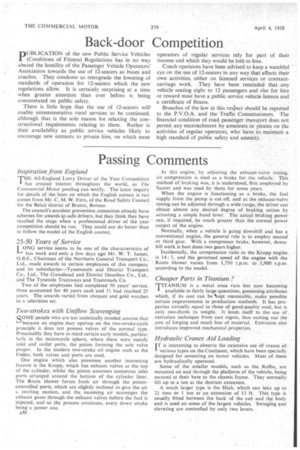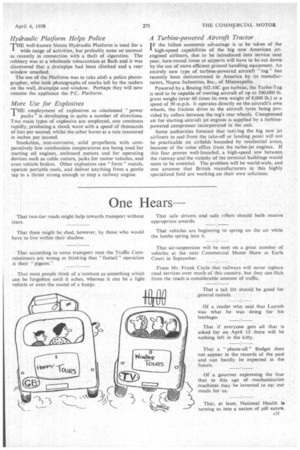Passing Comments
Page 32

Page 33

If you've noticed an error in this article please click here to report it so we can fix it.
Inspiration from England
THE All-England Lorry Driver of the Year Competition
has created interest throughout the world, as The Commercial Motor postbag can testify. The latest inquiry for details of the lines on which the English contest is run comes from Mr. C. M. W. Fern, of the Road Safety Council for the Belait district of Brunei, Borneo.
The council's accident prevention committee already have schemes for awards to safe drivers, but they think they have reached the stage when a professional driver of the year competition should be run. They could.not do better than to follow the model of the English contest.
25-50 Years of Service LONG service seems to be one of the characteristics of
bus work and only a few days ago Mr. W. T. James, 0.B.E., Chairman of the Northern General Transport Co., Ltd., made awards to certain employees of this company and its subsidiaries—Tynemouth and District Transport Co., Ltd., The Gateshead and District Omnibus Co., Ltd., and The Tyneside Tramways and Tramroads Co.
Two of the employees had completed 50 years' service, three accounted for 40 years each and 11 had reached 25 years. The awards varied from cheques and gold watches to a television set.
Two-strokes with Uniflow Scavenging
gomE people who are not technically minded assume that -' because an engine may operate on the two-stroke-cycle principle it does not possess valves of the normal type. Presumably they have in mind certain early modelS, particularly in the motorcycle sphere, where there were merely inlet and outlet ports, the piston forming the sole valve proper. In the modern two-stroke oil engine such as the Foden, both valves and ports are used.
One engine which also possesses another interesting feature is the Krupp, which has exhaust valves at the top of the cylinder, whilst the piston uncovers numerous inlet ports arranged around the bottom of the cylinder liner. The Roots blower forces fresh air through the pistoncontrolled ports, which are slightly inclined togive the air a swirling motion, and the incoming air scavenges the exhaust gases through the exhaust valves before the fuel is injected, and so the process continues, every down stroke being a power one.
A30
In this engine, by adjusting the exhaust-valve timing, air. compression is used as a brake for the vehicle. This method of braking was, it is understood, first employed by Saurer and was used by them for some years.
When the engine is functioning as a brake, the fuel supply from the pump is Cut off, and as the exhaust-valve timing can be adjusted through a wide range, the driver can obtain almost any desired degree of braking action by actuating a simple hand lever. The actual braking power can, if required, be much greater than the normal power output of the engine.
Normally, when a vehicle is going downhill and has a conventional engine, the general rule is to employ second or third gear. With a compressor brake, however, downhill work is best done two gears higher.
Incidentally, the compression ratio in the Krupp engine is 14: 1, and the governed speed of the engine with the Roots blower varies from 1,750 r.p.m. to .1,900 r.p.m. according to the model.
Cheaper Parts in Titanium ?
TITANIUM is a metal once rare but now becoming A available in fairly large quantities, possessing attributes which, if its cost can be kept reasonable, make possible certain improvements in production methods. It has properties virtually equal to those of good-quality steel, but is only two-thirds its weight. It lends itself to theuse of extrusion technique from cast ingots, thus cutting out the cost of forging and much loss of material. Extrusion also introduces improved mechanical properties.
"Hydraulic Cranes Aid Loading
I T is interesting to observe the extensive use of. cranes of various types on the Continent, which have been specially designed for mounting on motor vehicles. Most of these are hydraulically operated.
Some of the srrialler models, such as the Rolba, are mounted on and through the platform of the vehicle, being secured at their base to the chassis frame. They normally lift up to a ton at the shortest extension.
A much larger type is the Hiab, which can take up to 21 tons or 1 ton at an extension of 13 ft. This type is usually fitted between the back of the cab and the body and is used on some of the largest vehicles. Swinging and elevating are controlled by only two levers.
Hydraulic Platform Helps Police
THE well-known Simon Hydraulic Platform is used for a I wide range of activities, but probably none so unusual as recently in connection with a theft of cigarettes. The robbery was at a wholesale tobacconists at Bath and it was discovered that a drainpipe had been climbed and a rear window smashed.
The use of the Platform was to take aloft a police photographer, who took photographs of marks left by the raiders on the wall, drainpipe and window. Perhaps they will now rename the appliance the P.C. Platform.
More Use for Explosives
THE employment of explosives as condensed "power
packs" is developing in quite a number of directions. Two main types of explosive are employed, one combusts rapidly, producing-a shock wave with a speed of thousands of feet per second, whilst the other burns at a rate measured in inches per second.
Smokeless, non-corrosive, solid propellents with comparatively low combustion temperatures are being used for starting oil engines, outboard _motors and for operating devices such as cable cutters, jacks for motor vehicles, and even vehicle brakes. Other explosives can " form " metals, operate portable tools, and deliver anything from a gentle tap to a thrust strong enough to stop a railway engine.
A Turbine-powered Aircraft Tractor
JF the fullest economic advantage is to be taken of the high-speed capabilities of the big new American jetengined airliners, due to be introduced into service next year, turn-round times at airports will have to be cut down by the use of more efficient ground handling equipment. An entirely new type_ of turbine-powered aircraft "tug" has recently been demonstrated in America by its manufacturers, Napco Industries, Inc., of Minneapolis.
Powered by a Boeing 502-10C gas turbine, the Turbo-Tug is said to be capable of moving aircraft of up to 500,000 lb. gross weight (over 60 times its own weight of 8,000 lb.) at a speed of 30 m.p.h. It operates directly on the aircraft's own wheels, the friction drive to the aircraft tyres being provided by rollers between the tug's rear wheels. Compressed air for starting aircraft jet engines is supplied by a turbinepowered compressor incorporated in the unit.
Some authorities forecast that taxi-ing the big new jet airliners to and from the take-off or landing point will not be practicable on airfields bounded by residential areas, because of the noise efflux from the turbo-jet engines. If this fear proves well-founded, a high-speed tow between the runway and the vicinity of the terminal buildings would seem to be essential. The problem will be world-wide, and one assumes that British manufacturers in this highly specialized field are working on their own solutions.












































































































